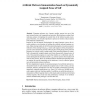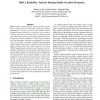96 search results - page 3 / 20 » Exploiting and Protecting Dynamic Code Generation |
ISW
2010
Springer
13 years 5 months ago
2010
Springer
Computer malwares (e.g., botnets, rootkits, spware) are one of the most serious threats to all computers and networks. Most malwares conduct their malicious actions via hijacking t...
USS
2004
13 years 8 months ago
2004
Buffer overflow exploits make use of the treatment of strings in C as character arrays rather than as first-class objects. Manipulation of arrays as pointers and primitive pointer...
WWW
2010
ACM
14 years 2 months ago
2010
ACM
JavaScript is a browser scripting language that allows developers to create sophisticated client-side interfaces for web applications. However, JavaScript code is also used to car...
SP
2008
IEEE
14 years 1 months ago
2008
IEEE
Attacks often exploit memory errors to gain control over the execution of vulnerable programs. These attacks remain a serious problem despite previous research on techniques to pr...
PPOPP
2009
ACM
14 years 8 months ago
2009
ACM
This paper introduces a new way to provide strong atomicity in an implementation of transactional memory. Strong atomicity lets us offer clear semantics to programs, even if they ...


